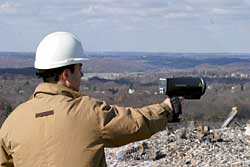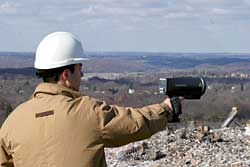
Silent but Deadly
This new laser device helps avoid explosive situations.
 COMPARED to, say, Uranus, the amount of methane on Earth isn't
anything to phone home about. Then again, here on the Third Rock we do
have human lives and safety to think about, and as we saw last year in
mining disasters from West Virginia to eastern Kentucky and elsewhere,
methane is among us in relative abundance, sometimes in deadly
concentrations. For those who work with or near the highly flammable
gas, keeping precise measurements of its presence is serious and
constant business.
COMPARED to, say, Uranus, the amount of methane on Earth isn't
anything to phone home about. Then again, here on the Third Rock we do
have human lives and safety to think about, and as we saw last year in
mining disasters from West Virginia to eastern Kentucky and elsewhere,
methane is among us in relative abundance, sometimes in deadly
concentrations. For those who work with or near the highly flammable
gas, keeping precise measurements of its presence is serious and
constant business.
Methane is virtually everywhere on this planet, including in your
office. Depending on what you had for breakfast, it's more prevalent in
some of your offices than others, but unless your desk is situated in
the middle of a landfill or feedlot, the amounts are usually
negligible, somewhere in the vicinity of 1.7 parts per million. At such
a level, the colorless, odorless gas is innocuous. Even at 10,000 ppm
(or 1 percent by volume), methane is not volatile. Its Lower Explosive
Limit (LEL) is 5 percent by volume, and if you ever find yourself amid
ppm of that magnitude, you definitely do not want to light a match.
Fugitive Emissions
Major methane sources include landfills, coal mines, oil and
natural gas fields, pipeline systems, and animal waste management
facilities. At such sites, the U.S. Environmental Protection Agency
regulates acceptable emission levels. At landfills, where gas just
rises from the ground, EPA's legal limit for methane is a mere 500 ppm.
Considering the gas's LEL is about 100 times that amount, the agency's
threshold limit may seem low, but according to EPA it is still enough
to pose environmental hazards because of methane's heat-trapping
qualities. While it is the second-most-abundant greenhouse gas, methane
traps 20 percent more heat in the atmosphere than carbon dioxide and,
according to EPA, remains there for nine to 15 years.
Alan Skinner, business development manager of fixed systems for
Crowcon Detection Instruments in Erlanger, Ky., has worked in the gas
detection industry for 32 years and says there has never been a greater
need for, nor more emphasis placed on, getting highly accurate methane
measurements. Historically, he says, achieving even rough measurements
required site surveyors to conduct atmospheric tests every 30 feet or
so, taking a sample and logging the data before moving on to the next
test; even if each sample took only 30 seconds, the process was arduous
at best, especially if the site was your typical 25-acre landfill.
During the past decade or more, though, surveying equipment has
evolved, Skinner says, and the newest advancement is a device called
the LaserMethane®, a hand-held instrument that uses "point-and-shoot"
technology to detect methane concentrations between 10 and 10,000 ppm
from up to about 490 feet away in less than 0.1 seconds--even through
glass.
Manufactured in Japan by Tokyo Gas Engineering and distributed
exclusively by Crowcon, the device resembles a police officer's radar
gun and operates on roughly the same principle, though it measures gas
instead of speed/distance. Skinner describes it as "basically a fixed,
open-path detection principle put into a portable, which has never been
done before." The unit can be situated in a permanent position to scan
a given area, but part of its appeal is that it also can be packed up,
taken to a site, and used to pinpoint methane measurements without the
surveyor's ever having to leave his or her vehicle.
Surpassing Gas Detection
The LaserMethane's ability to detect methane faster and at lower
levels than ever before comes from its built-in Class 1 and Class 2
lasers that cue in on the molecules of methane gas while ignoring all
others. "With the traditional open-path system in which you use
infrared light, the detector is susceptible to all hydrocarbon gases,
but with ours there's no cross-interference from any other gas, nor is
it affected by any other substance," Skinner says. Once the lasers are
deployed, they reflect off any surface, such as a blade of grass, and
send a measurement back almost instantly to the unit, which displays
the reading along with the signal strength on its LCD panel. While the
lasers work well through glass or clear plastic, darker colors hamper
their reflective abilities.
A two-stage trigger serves both to deploy the lasers and to
automatically log up to about 10,000 data points, which are saved in a
graphical format to the LaserMethane's built-in SD memory card, which
comes standard with the 06A Model. The saved data can then be
downloaded to a PC for a ready-made date- and time-stamped spreadsheet.
The device is programmable and can be set to log data at various
intervals down to a second. An internal cell self-calibrates the
instrument at switch-on and during use.
Depending on options, this technology costs anywhere from $22,000 to
$30,000, which seems pricey until it's compared to the time and money
involved in the remediation work and potential fines that can result
from excessive and undetected emissions.
This column appeared in the March 2007 issue of Occupational Health & Safety.
This article originally appeared in the March 2007 issue of Occupational Health & Safety.